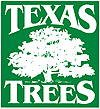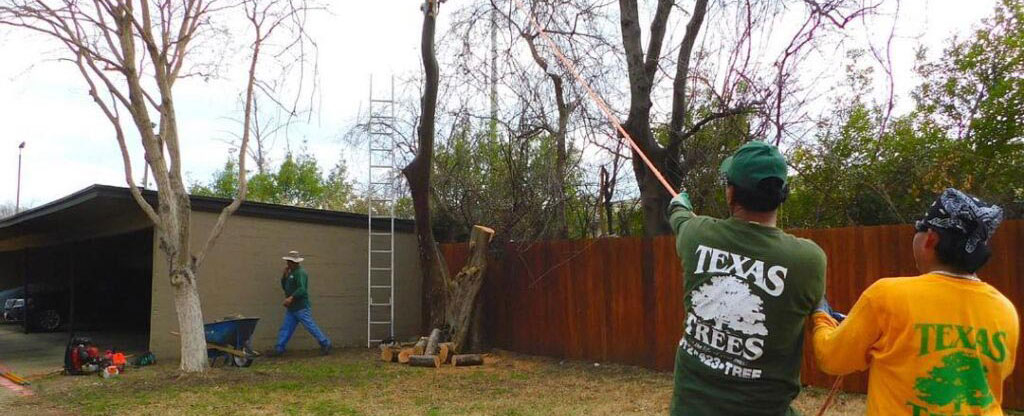Some trees, such as the redwood trees, can live a whopping 1000+ years! However, the common oak trees found in North Texas live about 100-500+ years. Typical trees found in Texas include the live oak or lacey oak tree and the cedar elms.
But the sad truth is that all trees die. A day comes when the generous summer shade, the ornamental season-changing leaves, and the branches’ gentle sway cease to exist.
There are signs that your giant tree is dead or dying. They include sap seeping out, dead branches, cracked trunks, or holes in the tree.
What Do You Do When Your Giant Tree Dies
The first step is to make sure that your tree is 100% dead. If an arborist confirms it is, your old tree opens another window. There are numerous dead tree decorating ideas or other fascinating projects you can use once you’re at this stage.
A giant dead tree is still worthy. With it, you can adorn and restore the allure of your landscape.
Should You Cut Your Giant Tree
It would be best to cut some trees as soon as possible. The Texas ash tree, for instance, is quite brittle and won’t hold for long if dead. Also, giant dead trees near playgrounds or other people’s property pose a significant danger.
Typically, Texas trees don’t grow to those skyscraper-like heights of the Hyperion tree and its ilk in northern California. However, a giant tree can still weigh about 4000 pounds. And it’s quite risky if more than 4 tons come tumbling down in a populated area. You may have to pay for some damages at best or account for injuries at worst.
If you cut it, what can you do with a giant chopped-down tree?
Wood Chips, Mulch and Firewood
Mulching is the simplest way to make use of your chopped down dead tree. Mulch gives several advantages, among them being landscape enhancement, plant protection, and conservation of water. And you can rent a wood chipper at an affordable price to hasten the job.
To some people, cutting and stacking firewood is a painstaking job. But if you have time on your hand, it may be an excellent way to put your muscles to the test.
Tree Cookies Walkway
You can use tree pathways in place of the traditional/concrete ones. The natural beauty of wood makes an alluring walkway to your porch. And you can arrange the cross cuts to fit any patterns you have in mind. Cut the dead tree stump into thin cookies and place them on steady materials like mulch to make sure they are permanent.
Remember, wood rots easily. Therefore, precautions like oil or sealing them in will ensure long life while retaining your walkway’s glamour.
Bee Hotel/ Vases
You can hire experts to help you with dead tree snag art ideas. There are excellent ideas like making a beehive for your backyard.
We’ve all heard about the importance of bees to our ecosystem. And one or two bee habitats may be the way to go. Native bees may not get much media coverage like other bees, but they are also an endangered species.
The same hollowed-out designs also make excellent vases for vines, vegetables, or flowers.
Alternatively, four giant logs can be placed at the edges of your garden to raise it and prevent soil from spilling over. The logs further enhance the natural aura with the mushrooms, ferns, or moss sprouting on it.
Lumber
Can your tree produce valuable and durable timber? If a professional can confirm its worth, you can get lumber for your home projects. This also goes in the book as a conservation effort since it takes the toll off live trees when you use giant dead trees- if many people take such an approach.
For the best timber, call reliable tree surgeons in Fort Worth to bring a portable sawmill.
Furniture
Wood furniture is simply beautiful. You can make a hollowed-out throne with your dead tree snag, rustic coffee tables, simple bleachers, mats, and more.
Using A Standing Giant Dead Tree
Does the tree(s) have lingering memories of your childhood swing, cherished picnic moments, or carved sweetheart vows? Then the tree may be like that old t-shirt you hold on to despite its weather-beaten look. If you are sure that the types of trees in your backyard are still robust after death, feel free to unleash your creativity.
Let’s look at awesome projects for your standing dead snag.
Nesting/ Habitat
You don’t have to be an ornithologist to appreciate the beauty of birds. Your dead tree stump is an easier target for birds and animals to peck and burrow. Woodpeckers, bats, owls, titmice, chickadees, nuthatches, brown creepers may find a haven there. It’s also an excellent habitat for animals and insects like squirrels, martens, raccoons, and butterflies.
Landscape Enhancement
Nothing traverses nature’s beauty. However, you may still inject some life into your standing dead tree with blossoming plants and flowers. Climbing vines, for example, will find perfect hosts when planted near these trees. Also, your giant dead trees can make an excellent fence for your garden.
Artistic Projects
In art, you lose yourself and gain yourself at the same time. The oldest tree in your yard may be an eyesore, but some imagination is all you need. You can go a step further and paint your dead tree with glow-in-the-dark paint for the oomph.
Carving is an even grander artwork for your dead tree stump. There are dozens of inspirational carvings gracing the internet, from majestic bald eagles to historical icons. For professional looking sculptures and paintings, you can hire a painter or sculptor in Fort Worth.
Dead tree branch decorations are also incredible for interior décor. These decorating ideas need creativity and skill. Examples include coat hangers, towel holders, wind chimes, candle holders, chandelier-like crafts, bed headboards, wall decorations, entrances, garden steps, etc.
Environmental Stewardship: Sustainably Repurposing Your Giant Dead Tree
Making Eco-Friendly Choices
In this era of heightened environmental consciousness, making sustainable choices during the repurposing process is crucial. Opt for eco-friendly materials and methods that leave a minimal carbon footprint. Consider natural alternatives to oils or sealants, allowing your giant dead tree to decompose naturally and contribute to the ecosystem in the long run.
Preserving Biodiversity: A Habitat for Wildlife
Transforming your dead tree into a haven for birds, bats, and insects not only adds a touch of nature’s beauty to your landscape but also aids in preserving biodiversity. This living habitat becomes a sanctuary for various species, contributing to the delicate balance of your local ecosystem.
Conserving Resources: Responsible Use of Timber
When contemplating the use of timber from your giant dead tree, prioritize responsible forestry practices. Consult certified professionals to ensure your timber usage supports conservation efforts rather than depleting valuable resources. This mindful approach aligns your repurposing efforts with a commitment to environmental stewardship.
Mindful Mulching and Landscaping Practices
While mulching offers manifold benefits, it’s essential to approach the process mindfully. Choose eco-friendly materials for mulching and consider natural alternatives to oils or sealants. Allowing the dead tree to decompose naturally fosters a sustainable landscape and ensures the long-term health of your outdoor space.
Educational Opportunities: Promoting Environmental Awareness
Consider using the repurposing process as an educational opportunity. Engage your community, neighbors, or local schools in understanding the life cycle of trees and the importance of responsible tree management. Fostering environmental awareness contributes to a more informed and eco-conscious community.
Future Generations: Planting Seeds for Tomorrow
As a final gesture in your giant dead tree’s journey, consider planting new saplings or native trees in its place. This symbolic act not only signifies the continuation of life but also ensures a green legacy for future generations to cherish. It becomes a testament to your commitment to sustainable practices and environmental conservation.
How Long Will The Giant Dead Tree Remain Standing?
Even tree surgeons or arborists in North Texas find it hard to give a precise timeline. Some trees have been dead for more than five decades, while others won’t withstand the next storm. The safer option is to get tree experts in Fort Worth to chop it down as soon as possible or check its robustness.
Remember that trees, like humans, don’t necessarily die of old age. Others succumb to lightning, tree diseases, animal attack, drought, bugs, root competition, or lack of sunlight. If your giant tree dies from a tree disease, avoid using it for mulching.
One Last Thing
Embracing the life cycle of a giant dead tree unlocks a realm of possibilities that transcend its physical demise. From crafting functional items like wood chips, mulch, and firewood to transforming it into captivating art installations, the creative potential is boundless. The choice between repurposing fallen timber and creating a habitat for wildlife reflects an environmentally conscious mindset. Beyond aesthetics, the educational and community-building aspects of such endeavors enrich the tapestry of your surroundings. Whether carved into intricate sculptures or allowed to stand as a natural habitat, your giant dead tree becomes a testament to the harmonious coexistence of nature and human creativity. As you embark on this journey, guided by mindful choices, you contribute to the legacy of sustainability and environmental stewardship, leaving an enduring impact on your landscape and the generations to come.
Always hire certified, covered, and bonded tree surgeons or arborists in Fort Worth to remove the heavy branches or treetops.
Contact us for more information.
Slotting in a dead tree stump into your landscape design can be an exciting artistic or arboreal venture. Nature will sing your praises in twitters, hoots, croaks, and squeaks.

